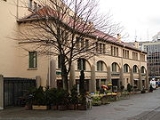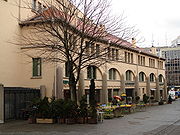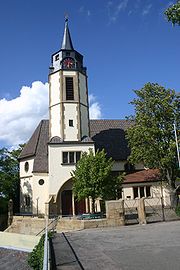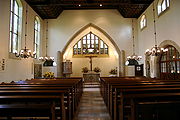
Martin Elsaesser
Encyclopedia
Martin Elsaesser was a German architect
and professor of architecture. He is especially well known for the many churches he built. He was born in Tübingen
, Germany on 28 May 1884 but died in Stuttgart
, 5 August 1957.
at the Technical University of Munich
under Friedrich von Thiersch and the Technical University of Stuttgart
under Theodor Fischer
. In 1905 he won the competition for the Lutheran church of Baden-Baden
and started to be active as a freelance architect.
From 1911 to 1913 he served as an assistant to Professor Paul Bonatz
, at Stuttgart Technical University. In 1913, he became prrofessor for medieval architecture
at the same institution (until 1920).
From 1920 to 1925 he was managing director of the School of Arts and Crafts at Cologne (later known as the Kölner Werkschulen
). In 1925, Ernst May
, then government building surveyor in Frankfurt am Main, made him chief of the city's municipal building department. Elsaesser kept that post until 1932. His largest construction during his time at Frankfurt was the Grossmarkthalle.
During the reign of National Socialism, Elsaesser did not receive any commissions. Nonetheless, he did not opt for emigration; instead he spent the war years
in internal exile
, pursuing architectural study tours and utopian designs.
After the war, he was professor of design at Munich Technical University from 1947 to 1956.
Many of his churches contain paintings by the artist Käte Schaller-Härlin.
His grandson is the international film historian Thomas Elsaesser
.



Architect
An architect is a person trained in the planning, design and oversight of the construction of buildings. To practice architecture means to offer or render services in connection with the design and construction of a building, or group of buildings and the space within the site surrounding the...
and professor of architecture. He is especially well known for the many churches he built. He was born in Tübingen
Tübingen
Tübingen is a traditional university town in central Baden-Württemberg, Germany. It is situated south of the state capital, Stuttgart, on a ridge between the Neckar and Ammer rivers.-Geography:...
, Germany on 28 May 1884 but died in Stuttgart
Stuttgart
Stuttgart is the capital of the state of Baden-Württemberg in southern Germany. The sixth-largest city in Germany, Stuttgart has a population of 600,038 while the metropolitan area has a population of 5.3 million ....
, 5 August 1957.
Life
From 1901 to 1906, Elsaesser studied architectureArchitecture
Architecture is both the process and product of planning, designing and construction. Architectural works, in the material form of buildings, are often perceived as cultural and political symbols and as works of art...
at the Technical University of Munich
Technical University of Munich
The Technische Universität München is a research university with campuses in Munich, Garching, and Weihenstephan...
under Friedrich von Thiersch and the Technical University of Stuttgart
University of Stuttgart
The University of Stuttgart is a university located in Stuttgart, Germany. It was founded in 1829 and is organized in 10 faculties....
under Theodor Fischer
Theodor Fischer
Theodor Fischer was a German architect and teacher.Fischer planned public housing projects for the city of Munich beginning in 1893. He was the joint founder and first chairman of the Deutscher Werkbund , as well as member of the German version of the Garden city movement...
. In 1905 he won the competition for the Lutheran church of Baden-Baden
Baden-Baden
Baden-Baden is a spa town in Baden-Württemberg, Germany. It is located on the western foothills of the Black Forest, on the banks of the Oos River, in the region of Karlsruhe...
and started to be active as a freelance architect.
From 1911 to 1913 he served as an assistant to Professor Paul Bonatz
Paul Bonatz
Paul Bonatz was a German architect, member of the Stuttgart School and professor at the technical university in that city during part of World War II and from 1954 until his death....
, at Stuttgart Technical University. In 1913, he became prrofessor for medieval architecture
Medieval architecture
Medieval architecture is a term used to represent various forms of architecture common in Medieval Europe.-Characteristics:-Religious architecture:...
at the same institution (until 1920).
From 1920 to 1925 he was managing director of the School of Arts and Crafts at Cologne (later known as the Kölner Werkschulen
Kölner Werkschulen
The Kölner Werkschulen were a series of schools in Cologne training artists in visual arts, architecture and design from 1926 to 1971.- Directors :* 1879–1906: Friedrich Romberg, engineers* 1906–1910: Gustav Halmhuber, architect and painter...
). In 1925, Ernst May
Ernst May
Ernst May was a German architect and city planner.May successfully applied urban design techniques to the city of Frankfurt am Main during Germany's Weimar period, and in 1930 less successfully exported those ideas to Soviet Union cities, newly created under Stalinist rule...
, then government building surveyor in Frankfurt am Main, made him chief of the city's municipal building department. Elsaesser kept that post until 1932. His largest construction during his time at Frankfurt was the Grossmarkthalle.
During the reign of National Socialism, Elsaesser did not receive any commissions. Nonetheless, he did not opt for emigration; instead he spent the war years
World War II
World War II, or the Second World War , was a global conflict lasting from 1939 to 1945, involving most of the world's nations—including all of the great powers—eventually forming two opposing military alliances: the Allies and the Axis...
in internal exile
Internal Exile
Internal Exile was Fish's second solo album after leaving Marillion in 1988. The album, released 28 October 1991, was inspired by the singer's past, his own personal problems and his troubled experiences with his previous record label EMI.The album's music reflects Fish's indulgence in the vast...
, pursuing architectural study tours and utopian designs.
After the war, he was professor of design at Munich Technical University from 1947 to 1956.
Many of his churches contain paintings by the artist Käte Schaller-Härlin.
His grandson is the international film historian Thomas Elsaesser
Thomas Elsaesser
Thomas Elsaesser is an international film historian and professor of Film and Television Studies at the University of Amsterdam.-Biography:Thomas Elsaesser was born in 1943 in Berlin...
.
Buildings (selection)



- 1909: Königliche Fachschule für Edelmetallindustrie Schwäbisch GmündSchwäbisch GmündSchwäbisch Gmünd is a town in the eastern part of the German state of Baden-Württemberg. With a population of around 62,000, the town is the second largest in the Ostalbkreis and the whole region of East Württemberg after Aalen...
, today Hochschule für Gestaltung - 1909-1910: Lutheran church of St. Eberhard, TübingenTübingenTübingen is a traditional university town in central Baden-Württemberg, Germany. It is situated south of the state capital, Stuttgart, on a ridge between the Neckar and Ammer rivers.-Geography:...
- 1909-1910: Secondary School, Tübingen
- 1910: Railway bridge, Tübingen
- 1910-1913: Lutheran Church, Stuttgart-Gaisburg
- 1911: Lutheran church of St. George, MassenbachSchwaigernSchwaigern is a town in the district of Heilbronn, Baden-Württemberg, Germany. It is situated 12 km west of Heilbronn.-Neighbouring municipalities:...
- 1911-1914: Covered market, StuttgartStuttgartStuttgart is the capital of the state of Baden-Württemberg in southern Germany. The sixth-largest city in Germany, Stuttgart has a population of 600,038 while the metropolitan area has a population of 5.3 million ....
- 1913-1914: Wagenburg-Gymnasium (secondary school), Stuttgart-Gänsheide
- 1922-1924: extension to Kölner WerkschulenKölner WerkschulenThe Kölner Werkschulen were a series of schools in Cologne training artists in visual arts, architecture and design from 1926 to 1971.- Directors :* 1879–1906: Friedrich Romberg, engineers* 1906–1910: Gustav Halmhuber, architect and painter...
- 1922-1924: Office block for Rheinisches Braunkohlensyndikat, MannheimMannheimMannheim is a city in southwestern Germany. With about 315,000 inhabitants, Mannheim is the second-largest city in the Bundesland of Baden-Württemberg, following the capital city of Stuttgart....
- 1924-1925: Private home, Dr. S., CologneCologneCologne is Germany's fourth-largest city , and is the largest city both in the Germany Federal State of North Rhine-Westphalia and within the Rhine-Ruhr Metropolitan Area, one of the major European metropolitan areas with more than ten million inhabitants.Cologne is located on both sides of the...
- 1925-1926: Lutheran Südkirche, EsslingenEsslingen am NeckarEsslingen am Neckar is a city in the Stuttgart Region of Baden-Württemberg in southern Germany, capital of the District of Esslingen as well as the largest city in the district....
http://www.suedkirche-esslingen.de - 1925-1926: own home, Frankfurt am Main
- 1926: Part rebuilding of Lutheran Church of St. Laurentius, Stuttgart-Rohr (replaced in 1980)
- 1926-1928: Grossmarkthalle, Frankfurt am Main
- 1928-1929: Primary school in RömerstadtHeddernheim (Frankfurt am Main)Heddernheim is a district or Stadtteil of Frankfurt am Main, Germany. It is part of the Ortsbezirk Nord-West, and is subdivided into the Stadtbezirke Heddernheim-Ost and Heddernheim-West. Heddernheim was first mentioned in documents in 801 as Phetterenheim...
, Frankfurt am Main - 1930-1932: Villa Reemtsma, Hamburg-Altona
- 1937-1938: Sumerbank Headquarters, AnkaraAnkaraAnkara is the capital of Turkey and the country's second largest city after Istanbul. The city has a mean elevation of , and as of 2010 the metropolitan area in the entire Ankara Province had a population of 4.4 million....
, Turkey - 1950-1951: Residential high-rise, MunichMunichMunich The city's motto is "" . Before 2006, it was "Weltstadt mit Herz" . Its native name, , is derived from the Old High German Munichen, meaning "by the monks' place". The city's name derives from the monks of the Benedictine order who founded the city; hence the monk depicted on the city's coat...
- 1953-1954: Rebuilding of Gustav-Siegle-Haus (Stuttgart Philharmonic)

